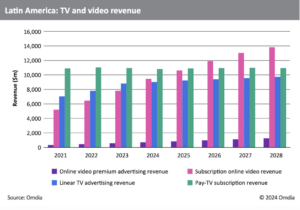news
TBI Tech & Analysis: Why ad-supported streaming is set to boom in Latin America


Pact Of Silence (Source: Netflix)
With Netflix having already rolled out its ‘Basic with Ads’ tier in Latin America, all major SVOD services in the region are now expected to launch ad-supported plans in 2024. Digging into this trend, Omdia research analyst Juan Villegas explores why the SVOD one-size-fits-all model no longer fits in Latin America.
Latin America has great potential for hybrid ad-supported streaming services and other alternative models, including mobile-only SVOD tiers. In addition, early signs suggest hybrid services are likely to do well in the region. After the launch of ‘Basic with Ads’, market leader Netflix has consistently increased its subscriptions in Mexico and Brazil.
Historically, Latin America has tended toward lower-priced TV and video products and services, and in the era of online video, service providers leaning on alternative models, including mobile-only or hybrid ad-supported tiers, are most likely to succeed.
Hybrid plans represent an opportunity for players and consumers. For the players, they represent an additional revenue stream with the opportunity to increase market share by offering a range of plans. For the consumer, they offer a chance to save money on traditional plans.
In Latin America, the one-size-fits-all SVOD model popularized globally by Pact Of Silence streamer Netflix has failed to drive high SVOD household penetration rates comparable to those seen in other mature markets.In 2024, all major global SVODs will launch ad tiers in the region. Although this is a broad international trend, it is appropriate for a region where disposable income has suffered.
The 2020s have seen more diversification of the standard D2C offerings, driven in part by the increasing number of services in the market, ad-supported products, and the remaining factor: consumer spend and disposable income that is struggling to increase in size.
Given the increase in D2C usage versus traditional pay-TV since its peak in 2020, SVOD players have increased their pricing because of economic factors such as inflation. In Latin America, operators must introduce their plans at lower prices to drive scale; otherwise, they can struggle to grow. Some examples in other territories are Netflix’s mobile-only plan in India and the former free-mobile plan in Kenya.
High inflation in the region has squeezed average disposable income, leading to an average of two to three subscriptions per household. The existence of alternative plans can ease the pressure on budgets and potentially increase the stacking per home.
The report above was written by Juan Villegas, research analyst for media & entertainment, at research group Omdia, which – like TBI – is part of Informa. The report, ‘The SVOD one-size-fits-all model no longer fits in Latin America’ is available via Omdia’s monthly publication, Media Tech Digest.

